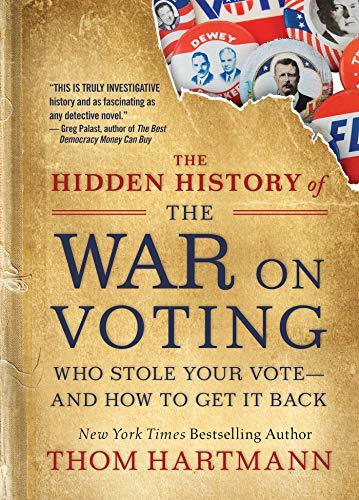
There is no constitutional right to vote in the United States. That confounding fact is at the heart of author Thom Hartmann’s revealing new book, The Hidden History of the War on Voting. In fewer than 200 pages, Hartmann reveals the many, often inventive ways that the ultra-wealthy, Right-Wing zealots, and white supremacists from the time of the Founding Fathers have suppressed the vote.
Estimated reading time: 6 minutes
Historically, both Democrats and Republicans have been responsible for denying the vote to those who were likely to oppose them. However, for the past half-century, since the Civil Rights and Voting Acts of the Johnson era and Richard Nixon’s Southern Strategy, voter suppression has been central to Republican efforts nationwide. Like Democrats under Jim Crow, Republicans have embraced restrictive voter ID laws, gerrymandering, and other underhanded tactics — and they have succeeded to an extent that few understand. There are partial solutions on the horizon in the House of Representatives and in state legislatures around the country. But the only way to roll back the war on voting in all its forms, Hartmann believes, is to amend the Constitution.
The Hidden History of the War on Voting: Who Stole Your Vote — and How to Get It Back by Thom Hartmann (2020) 192 pages ★★★★★
A Constitutional Amendment to end voter suppression
A Congressman from Wisconsin and several coauthors introduced such a proposed Amendment in the House in 2013. “Every citizen of the United States, who is of legal voting age,” the Amendment reads, “shall have the fundamental right to vote in any public election held in the jurisdiction in which the citizen resides.” Hartmann adds, “Such an amendment would completely flip upside down virtually all of the Republican’s Party’s many efforts to prevent people from voting.”
Unfortunately, given Republican control of the United States Senate and thirty-two state legislatures, there is little likelihood that this will pass in the foreseeable future. Because a Constitutional Amendment must be proposed by a vote of both the House and the Senate and then passed by three-fourths of the states. (There’s another way—two-thirds of the state legislatures may call a Constitutional Convention—but it has never been used, and it would be very dangerous to do so, because it would open the Constitution to wholesale revision.)
Voter suppression is central to Republican victories
Why should this be necessary in what is purported to be a democracy—the world’s oldest, in fact? Hartmann traces the modern antecedents to 1971 when future Supreme Court Justice Lewis Powell urged wealthy Americans and corporate leaders to invest in a long-term effort to turn back the New Deal. And one of the cornerstones of the strategy built on Powell’s thesis was voter suppression enforced by the courts and state legislatures alike. “Preventing ‘undesirable’ people from voting has become central to Republican victories for the past two generations,” Hartmann asserts. For example, the last two Republican Presidents have won despite losing the popular vote — and there is abundant evidence that neither one of them would have won even an Electoral College majority had widespread voter suppression efforts not been enacted in many key states.
Americans agree on the biggest issues. But the system is rigged.
In all the talk of polarization in American society, which of course is real enough, what’s lost is that there is overwhelming agreement on such fundamental issues as taxing the rich or taking action to combat the climate emergency. As Hartmann points out, “It’s not that Americans don’t agree on many issues; it’s that Americans have no way of achieving the policies they agree on.” By way of explanation, Hartmann cites a well-known “2014 study out of Princeton showing that the likelihood of legislation passing that represented the interests of the bottom 90 percent was equivalent, statistically, to white noise.” In the final analysis, this is the price we’re forced to pay for voter suppression.
So, is there hope?
Nearly all the steps Hartmann proposes to address the challenge of voter suppression are long shots at best in the current political climate. However, there is one effort underway that shows some promise. To date, fifteen states and the District of Columbia, representing 196 electoral votes, have adopted a measure to ensure a National Popular Vote. They have pledged to require their electors to vote for the winner of the nationwide popular vote instead of who won in that state. If other states representing 74 more electoral votes adopt this measure, the Electoral College will become a dead letter. At this point, considering that Republicans control 32 state legislatures, that’s not going to happen immediately.
But Democrats are taking great strides at the state level. Several “red” states are turning blue. Virginia, with 13 electoral votes, has already turned. Arizona, Pennsylvania, Wisconsin, North Carolina, and Florida are all tossups; collectively, they name 85 electors. Even vote-rich Texas (38 electoral votes) is a possibility. There is hope.
Brilliant investigative history
The War Against Voting is a brilliant example of investigative history. Hartmann casts light on many little-known episodes in the American past. Many of the voter-suppression efforts he writes about are blatant, making it difficult to understand how any self-respecting judge (much less a Justice of the US Supreme Court) could turn a blind eye to them. Other techniques are insidious and sometimes difficult to understand. Hartmann brings a fresh eye to all this, elucidating one of the most biggest threats to the integrity of American democracy.
About the author
Seven million people listen weekly to Thom Hartmann‘s nationally syndicated radio show, which he launched in 2003. He has written more than thirty books on diverse topics, including the four entries in the Hidden History series. The War on Voting is the most recent. Hartmann lives with his wife Louise in Portland, Oregon. They have three children.
For related reading
Check out:
- One Person No Vote: How Voter Suppression Is Destroying Our Democracy by Carol Anderson (Voter suppression, gerrymandering, and voter ID laws brilliantly explained)
- Dark Money: The Hidden History of the Billionaires Behind the Rise of the Radical Right by Jane Mayer (How the Koch brothers are revolutionizing American politics)
- Democracy in Chains: The Deep History of the Radical Right’s Stealth Plan for America by Nancy MacLean (Historical perspective on “the vast Right-Wing conspiracy”)
- The Loudest Voice in the Room: How the Brilliant, Bombastic Roger Ailes Built Fox News—and Divided a Country by Gabriel Sherman (Roger Ailes: the man who built Fox News and divided America)
You might also be interested in:
- Top 10 nonfiction books about politics
- Top 20 popular books for understanding American history
- The top 5 books about Donald Trump and his impact on American democracy
And you can always find my most popular reviews, and the most recent ones,, on the Home Page.


























